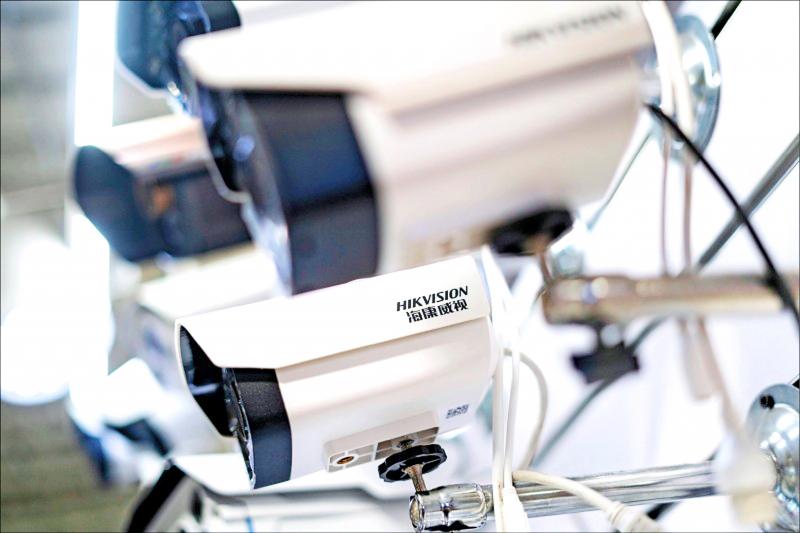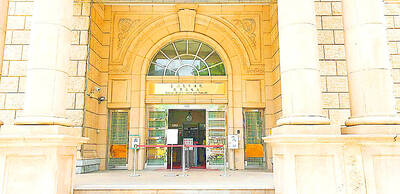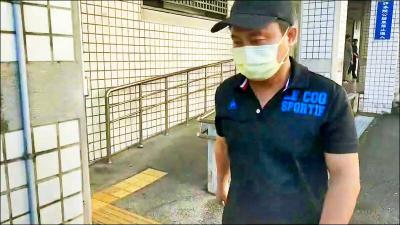An audit of the nation’s public schools found that 1,089 surveillance cameras made by the banned Chinese company Hikvision Digital Technology Co have been used at 16 schools over the past four years, the Ministry of Education (MOE) said yesterday.
The Executive Yuan has yet to release a comprehensive list of banned Chinese products since it pledged to do so nearly one year ago.
That is because the Chinese companies in question have been releasing new products, rendering any such list quickly obsolete, a source said.

Photo: AFP
The Executive Yuan has held interdepartmental meetings to tackle the issue, but failed to reach a consensus, the source said.
One issue is that not all products of some companies pose information security problems, the source said.
The government is concerned that it might cause misconceptions if it banned one or two items from a largely safe manufacturer, the source said.
The Executive Yuan late last month sent a report to the Legislative Yuan about Chinese-made information technology products being used at government agencies.
A majority of the products were made by Hikvision, the report said, adding that a total of 366 devices made by the company were being used by four central government agencies, 15 local government departments and 17 public schools.
A total of 179 of the devices were being used at public schools, the report showed.
However, the ministry’s audit showed that there were 1,089 Hikvision devices on public school campuses — about six times the number reported by the Executive Yuan, the source said.
The finding was particularly worrying for the nation’s information security officials, as Hikvision has close ties with the Chinese government, and its facial recognition technology has been used to suppress China’s Uighur Muslim population, the source said.
A report in July last year by Democratic Progressive Party (DPP) Taichung City Councilor Chiang Chao-kuo (江肇國) on the use of Hikvision cameras in the city’s underpasses was followed by reports of the company’s cameras being used at National Taiwan University, National Sun Yat-sen University and other public schools.
The schools stopped using the cameras after an investigation by the ministry.
However, 13 schools are still using the cameras, citing “no concerns” over the technology, the ministry said, adding that it has written to the schools asking them to stop using the devices to protect students and ensure campus safety.

South Korean K-pop girl group Blackpink are to make Kaohsiung the first stop on their Asia tour when they perform at Kaohsiung National Stadium on Oct. 18 and 19, the event organizer said yesterday. The upcoming performances will also make Blackpink the first girl group ever to perform twice at the stadium. It will be the group’s third visit to Taiwan to stage a concert. The last time Blackpink held a concert in the city was in March 2023. Their first concert in Taiwan was on March 3, 2019, at NTSU Arena (Linkou Arena). The group’s 2022-2023 “Born Pink” tour set a

CPBL players, cheerleaders and officials pose at a news conference in Taipei yesterday announcing the upcoming All-Star Game. This year’s CPBL All-Star Weekend is to be held at the Taipei Dome on July 19 and 20.

The Taiwan High Court yesterday upheld a lower court’s decision that ruled in favor of former president Tsai Ing-wen (蔡英文) regarding the legitimacy of her doctoral degree. The issue surrounding Tsai’s academic credentials was raised by former political talk show host Dennis Peng (彭文正) in a Facebook post in June 2019, when Tsai was seeking re-election. Peng has repeatedly accused Tsai of never completing her doctoral dissertation to get a doctoral degree in law from the London School of Economics and Political Science (LSE) in 1984. He subsequently filed a declaratory action charging that

The Hualien Branch of the High Court today sentenced the main suspect in the 2021 fatal derailment of the Taroko Express to 12 years and six months in jail in the second trial of the suspect for his role in Taiwan’s deadliest train crash. Lee Yi-hsiang (李義祥), the driver of a crane truck that fell onto the tracks and which the the Taiwan Railways Administration's (TRA) train crashed into in an accident that killed 49 people and injured 200, was sentenced to seven years and 10 months in the first trial by the Hualien District Court in 2022. Hoa Van Hao, a